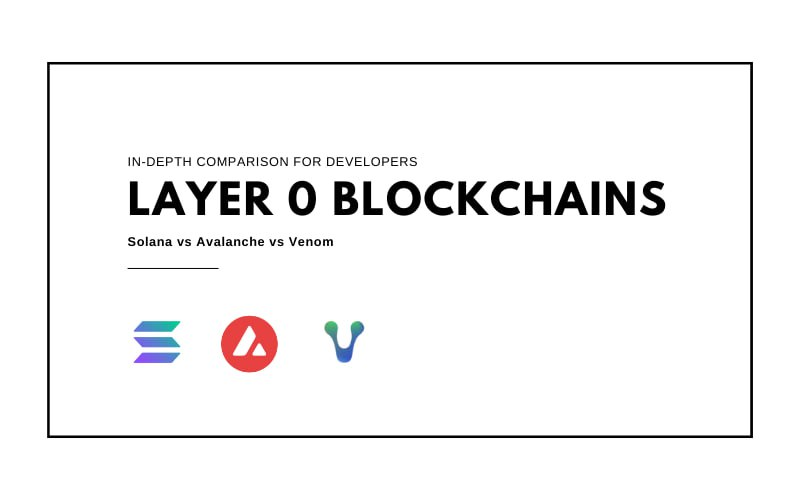
Layer 0 blockchains are the foundational protocols that underpin Layer 1 and 2 blockchain networks and Layer 3 decentralized applications (dApps).
As the adoption of blockchain ecosystems grows, Layer 0 protocols provide a highly scalable, secure, and interoperable infrastructure that provides a basis for building reliable decentralized networks and services.
Layer 0 protocols give blockchain developers the flexibility they need to customize the types of applications they want to build.
This article aims to provide a comprehensive comparison of the top Layer 0 blockchains, including Avalanche vs Solana vs Venom. It will discuss their key features, use cases, adoption trends, and technical considerations, enabling readers to make informed decisions about which blockchain platform to use or invest in.
How Do Layer 0 Blockchains Work?
Layer 0 protocols are designed to provide a base layer for blockchain networks like Bitcoin and Ethereum to avoid the increase in network congestion as usage grows and solve the so-called "blockchain trilemma": the challenge of increasing blockchain scalability, interoperability, and security simultaneously.
The importance of Layer 0 protocols lies in their ability to increase the scalability and interoperability of blockchain networks to introduce new decentralized applications and services while maintaining security. They enable the development and deployment of innovative solutions that can meet the demands of a growing user base and a diverse set of use cases.
Layer 0 blockchains provide the foundation for the main Layer 1 blockchain as well as Layer 2 scaling solutions, which improve the performance of Layer 1 by operating on top of the network. Blockchains that are built on the same Layer 0 protocol can interact and share features without the need for bridging, making them more efficient. They also avoid the vulnerabilities that can result in malicious attacks on bridges.
While there are clusters of Layer 1 blockchains built on Layer 0 protocols, there are also cross-chain transfer protocols that enable tokens and data to be transferred across different blockchains.
Some of the top Layer 0 blockchains include Venom, Avalanche, Cosmos and Polkadot.
Venom, Solana and Avalanche are smart contract blockchains that aim to compete with Ethereum by providing low-cost and scalable networks with high transaction processing rates to enable developers to create smart contracts and (dApps). Each network differs in how it aims to achieve this, using various architectures, consensus mechanisms and token economics.
Avalanche was founded in 2020 by Ava Labs. Solana's technology was first outlined in 2017 and the blockchain went live in 2020. Venom has been developed for several years. In 2022 Venom development entered the final stage before launch.
Key features of Venom, Avalanche, and Other Layer 0 Blockchains
|
Metric/Blockchain |
Venom |
Avalanche |
Cosmos |
Polkadot |
|
Consensus Mechanism |
Venom Consensus Protocol, PoS consensus (Byzantine fault-tolerant) |
Avalanche Consensus (Proof-of-Stake) |
Tendermint BFT |
Nominated Proof-of-Stake |
|
Scalability |
Dynamic sharding protocol and workchains (masterchain, workchain, shardchains) |
Scalable via "Subnets" |
Scalable via independent, interconnected blockchains |
Heterogeneous multi-chain architecture (Parachains) |
|
Interoperability |
Cross-chain communication protocol between workchains |
Interoperable with Avalanche Warp Messaging, enabling communication between "Subnets" |
Inter-Blockchain Communication (IBC) protocol |
Enables cross-blockchain transfers of data or assets via "Parachains" |
|
Security |
Advanced consensus mechanism (Byzantine fault tolerant) & auditing (CertiK & Hacken) |
Secure with Sybil resistance (PoS) |
Byzantine Fault Tolerant, validator-based |
Hierarchical inherited security |
|
Strengths |
Scalability, interoperability, and security |
EVM compatibility, |
Scalability, interoperability |
Scalability, interoperability |
|
Weaknesses |
Regulated can be seen as a weakness among crypto audience |
Trade-offs between decentralization and efficiency |
Reliance on hub-and-spoke model for interoperability |
Increased complexity due to multi-chain architecture |
Use Cases and Adoption of Layer 0 Blockchains
The adoption of Layer 0 blockchains is steadily increasing as the risks associated with centralized services become apparent and more people become aware of the benefits of decentralization. Demand for scalable, interoperable, and secure solutions is growing in industries like finance, gaming, and supply chain management.
Whether you are interested in building dApps, executing smart contracts, or creating and trading digital assets, Layer 0 blockchains provide the infrastructure for a range of innovative platforms and services.
The most well-known use case for Layer 0 blockchains is the creation and transfer of cryptocurrencies.
The Avalanche blockchain uses the AVAX token as its native cryptocurrency, which pays all network transaction fees, including those associated with smart contract execution and dApp functions. Holders of the AVAX token can also vote on governance proposals to direct the development of the underlying protocol.
The Solana blockchain's native token is SOL, which provides the basis for the PoS consensus mechanism and is used to pay transaction fees, interact with dApps and vote on governance proposals.
The Venom network's native VENOM token is used to settle transactions, incentive block validators, protect against malicious attacks, enable delegated staking, and participate in governance.
Solana operates a deflationary model for SOL, burning half of all the network's transaction fees to remove tokens from circulation, while Avalanche burns all AVAX fees. Reducing token supply increases scarcity and can potentially drive up token value as network adoption increases. Avalanche's higher rate of fee burning model could help AVAX become scarce more quickly than SOL.
Developers can use Layer 0 blockchains to execute smart contracts. These pieces of self-executing code can automate complex financial transactions and other types of agreements, providing the basis for a large and growing ecosystem of decentralized finance (DeFi) protocols, gaming platforms, and social networks.
Layer 0 blockchains have also become popular for the creation and trading of non-fungible tokens (NFTs), unique digital assets that are stored on a network.
Examples of successful implementation of Layer 0 protocols include DeFi platforms built on Avalanche, such as Pangolin, Trader Joe, 1inch and Aave, which have experienced rapid growth thanks to the network's high processing speeds and low transaction fees.
Polkadot has been adopted by various projects, like Acala Network and Moonbeam, which have built scalable and interoperable dApps on the platform.
Venom's workchains enable the Layer 0 platform to cater to various industries and applications, such as Central Bank Digital Currencies (CBDCs), DeFi, NFTs, and gaming. Venom allows for customization based on specific security, compliance, and privacy requirements, providing a flexible solution for a diverse range of applications and fostering innovation across sectors.
Technical Considerations for Layer 0 Blockchains
When deciding which Later 0 blockchain to adopt, developers need to take into account technical considerations such as the development tools, programming languages and smart contract compatibility they offer.
Programming Languages
Solana supports programs written in the Rust, C, C++ and Typescript languages. Although Solana is not fully compatible with Ethereum, Rust is an accessible programming language that even non-developers can use to build apps.
Avalanche is fully compatible with the Solidity programming language, which developers use to write smart contracts on the Ethereum network. Avalanche also supports the Go, Typescript, and Vue languages.
Venom uses Threaded Solidity, making it easy for developers to make the transition over the network from other blockchains. The biggest difference with the TON blockchain is that the coding language has been rewritten from C++ to Rust to make it more secure and upgradable. The security of Rust also provides robust security with low-level items such as memory and thread safety.
Smart Contracts
Avalanche is fully compatible with the Ethereum Virtual Machine (EVM), enabling Ethereum developers to build and deploy smart contracts on the Avalanche blockchain using standard Ethereum tools. This makes it straightforward for developers to migrate smart contracts, and create and transfer apps from Ethereum to Avalanche and vice versa quickly.
Solana's smart contract framework is not natively compatible with EVM, although the Neon EVM allows developers to run Ethereum smart contracts on the Solana blockchain and migrate apps from Ethereum to Solana.
The Venom blockchain uses the Threaded Virtual Machine (TVM) for smart contracts, which enables higher customizability across all levels of the blockchain. In the future, the blockchain will support EVM to increase interoperability so that EVM-compatible apps can interact with the network.
Venom uses sharding to split the execution of smart contracts into smaller threads, or "shards," which are then processed by different validator groups in parallel. Unlike database sharding, where the data is split and distributed across multiple machines, the data remains common to all "shard validators," but they are responsible for executing different threads of the computation.
Practical Considerations for Layer 0 Blockchains
It is also essential to consider practical factors like transaction fees, network congestion, and gas prices, as they determine the user experience and in turn the adoption of the platform.
Lower fees and reduced network congestion are crucial for making blockchain technology accessible and cost-effective for a wider audience.
One of the major indicators of a blockchain's performance is its transaction speed. Bitcoin processes around seven transactions per second (tps), while Ethereum can process up to 30tps. But blockchains will need to be must faster to support mass adoption. Layer 0 blockchains address this by facilitating much faster processing speeds.
What are the differences in performance between Avalanche vs Solana vs Venom?
Solana is one of the fastest and most scalable blockchain networks, averaging around 3,900tps with a maximum rate of 65,000tps, an average fee of $0.00025 per transaction and an average block creation time of 400-800ms.
Solana uses an innovative hybrid consensus mechanism, which combines a Proof-of-History (PoH) protocol that orders transactions by timestamp based on cryptographic proofs with its byzantine fault tolerance (PBFT) protocol, Tower Consensus. The use of PoH contributes to Solana's high throughput rates, while Tower Consensus forms part of a Proof-of-Stake (PoS) mechanism that reduces network latency.
Unlike many blockchains that run their smart contracts on the Ethereum Virtual Machine, Solana employs a parallel smart contracts runtime, Sealevel, which implements a multi-threaded system to process data thousands of times faster than single-threaded systems.
In contrast, the Avalanche blockchain processes a much smaller number of transactions, averaging 20tps and scaling up to a maximum of 4,500tps.
Avalanche claims to be the fastest smart contracts platform, which comprises three interoperable blockchains: the Exchange Chain (X-Chain) facilitates asset creation and trading on exchanges; the Platform Chain (P-Chain) allows for the creation of public or private secondary networks; and the Contract Chain (C-Chain) processes smart contracts and dApps. The different chains use different consensus protocols and are designed to provide greater speed and scalability than running all blockchain processes on a single chain.
Avalanche's Snow consensus mechanism is a type of leaderless PoS protocol that allows validators to reach consensus faster than other PoS models, increasing speed, efficiency, and decentralization.
The Venom blockchain consists of two networks: the Masterchain and the Basechain. The Basechain is a workchain that executes smart contracts and supports dApps. Both networks use the Threaded Virtual Machine (TVM), with the Basechain offering lower storage and execution fees than the Masterchain.
Venom is a low-cost, fast and highly scalable blockchain, with an unmatched throughput rate of 100,000tps up to 1 million tps, a time to finality of 0.2-0.3 seconds, and an average transaction fee of $0.0002. The network has no technical limit to the number of users that can transact. This is enabled by dynamic sharding and a multi-chain design promoting interoperability. Venom is based on an asynchronous architecture, which incorporates a masterchain, workchains, and shardchains.
Venom's dynamic sharding protocol enables vertical scalability as the network can adapt to changes in load by splitting or merging shardchains as needed, improving its performance and maintaining high transaction speeds Each shardchain processes a specific range of contract addresses and transactions, allowing groups of validators to execute transactions simultaneously.
The workchains also enable horizontal scalability as developers can create separate blockchains for various applications, allowing the network to cater to the specific needs of different industries and applications by distributing the workload across multiple specialized blockchains with different sets of validators.
Venom's unique architecture and Byzantine fault tolerant (BFT) algorithm make it one of the few blockchains that can solve the problem of interoperability.
Challenges and Opportunities for Layer 0 Blockchains
Layer 0 blockchains must navigate the complex and evolving landscape of legal and regulatory requirements across different jurisdictions. This includes complying with anti-money laundering (AML) and know-your-customer (KYC) regulations. Ensuring compliance with these regulations can be challenging, as Layer 0 blockchains are designed to operate in a decentralized and anonymous way.
The Venom Foundation saw this as an opportunity and became the world's first licensed blockchain company to comply with international law and regulations. Venom was endorsed by Abu Dhabi Global Markets (ADGM) in October 2022 for utility token issuance, giving it the credibility to drive blockchain adoption forward. This approval enables Venom to operate within a secure and well-governed environment, ensuring compliance standards and fostering trust among its users, including retail customers, institutions, and sovereign nations.
Venom's underlying technology of Venom provides a solid infrastructure for seamless cross-border payments on a governmental level. Its license enables Venom to stimulate interoperability between blockchains, central bank digital currencies (CBDCs) and other financial institutions.
Blockchains face increasing legal and regulatory challenges as governments from China to the US and the UK crack down on cryptocurrency use. The regulatory environment is unclear in many jurisdictions, which makes it difficult for developers and businesses to understand how their activities will be regulated and creates uncertainty for users and investors.
The global nature of blockchains can create jurisdictional issues, as different countries have different laws and regulations governing blockchain technology, which makes it difficult to determine which laws apply to blockchains that operate across borders.
Layer 0 blockchains must also deal with technical challenges such as network downtime security, and privacy.
Venom is one of the few blockchains that offers Account Abstraction, a feature in blockchain technology that separates the management of assets from the smart contracts that interact with them. This not only increases flexibility in the way that assets are managed on a blockchain, but it also improves security by reducing the attack surface of smart contracts. Smart contracts can interact with the blockchain assets without having direct access to their underlying storage or transactions.
As the use of dApps, NFTs and other assets on blockchain networks has grown rapidly over the past few years, network downtime has become an increasingly important issue.
Avalanche has sometimes experienced periods of network congestion, although it has never experienced downtime. However, the Solana network has been plagued by several major outages caused by congestion, bugs in the code, and spam attacks.
The Solana network suffered 11 major outages and three minor outages in 2022, according to reports, with another occurring in February 2023 that disrupted the network's operation for 19 hours and required a validator to reboot it.
The challenges that blockchain protocols face in increasing scalability, interoperability and security as adoption grows create opportunities for innovation and growth in the development of Layer 0 blockchains.
Layer 0 blockchains have already been instrumental in the growth of the DeFi ecosystem with decentralized exchanges, lending platforms, and other financial applications built on blockchains with Layer 0 protocols as the foundation. As the demand for decentralized financial products and services continues to grow, we can expect to see continued innovation in this space.
Layer 0 blockchains are also enabling the development of dApps outside the financial sector, including social networking, gaming, and supply chain management.
By enabling interoperability between different blockchains, Layer 0 protocols allow for the seamless transfer of assets and data between networks, creating a more interconnected and efficient ecosystem that is more attractive and intuitive for users. More developers and enterprises are building and deploying dApps that can communicate and exchange data across networks, increasing demand for Layer 0 networks.
Avalanche vs Solana vs Venom: Final Thoughts
Avalanche, Solana, and Venom are leading the way in developing alternative smart contract platforms to Ethereum. Each is taking different approaches to solving the blockchain trilemma of increasing scalability without compromising on security or decentralization. All three networks offer lower transaction fees and higher processing speeds than Layer 1 blockchains like Bitcoin and Ethereum. However, Solana has experienced significant network downtime that has caused a drop in confidence and led to developers switching to other platforms.
Avalanche and Solana are faster than Ethereum, however Venom's dynamic sharding and dual-network structure allow it to process 100,000 tps, which can scale up to 1 million. This far outpaces Solana's maximum transaction rate of 65,000tps and Avalanche's 4,500tps.
Developers need to take into account technical considerations including smart contract compatibility and programming language, as well as practical considerations such as transaction fees, network congestion, and gas prices.
Layer 0 blockchains offer numerous opportunities for innovation and growth in a wide range of industries. As the technology continues to evolve and mature, we can expect to see even more innovative use cases and applications for Layer 0 blockchains in DeFi, dApps, NFTs, interoperability, and supply chain management, among other areas.
* This is a contributed article and this content does not necessarily represent the views of techtimes.com





